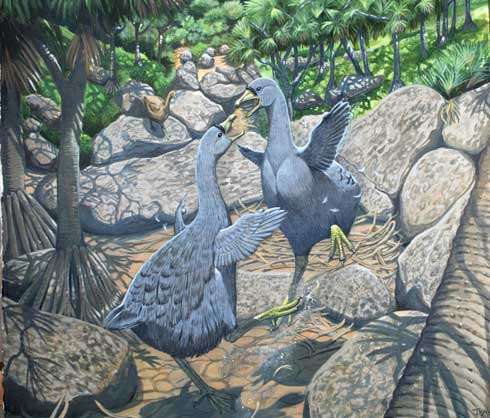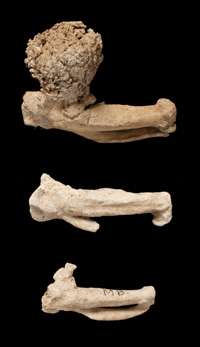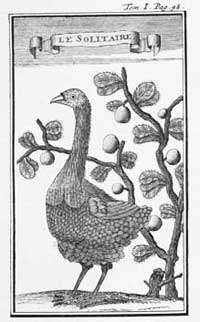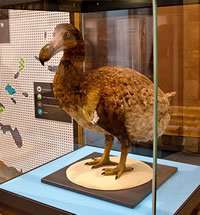Angry bird's unique wing weapon revealed

(Phys.org) —The solitaire bird was a giant flightless pigeon that, like its closest relative the dodo, became extinct soon after European explorers settled in its habitat. It had a strange knob-like ball on its wing and although it was known to be aggressive, it was unclear what this structure was for, until now.
Natural History Museum scientists have discovered that the ball was in fact a deadly weapon, used by the angry bird to defend territory and its mate.
Scientists Julian Hume and Lorna Steel studied records from the 18th and 19th centuries, when many detailed studies were written by Europeans explorers in Rodrigues, on the Mascarene Islands in the Indian Ocean. They also analysed in microscopic detail the ball structures on fossil solitaire bones.
They found that the so called 'musket ball' was indeed a weapon and that it was not found in any other bird. The largest they uncovered grew to 3.3cm, nearly as large as a ping-pong ball.
Both sexes had musket balls, but it was only the larger adult males, which grew to about the size of a goose, that had the largest growths, and they seemed to only occur once the bird had obtained a breeding territory and a mate to defend.
'The musket ball in the wing looked just like the lead balls that were fired out of an 18th century musket, which is why the early travellers to Rodrigues gave it that name,' says Lorna.
Sounds like thunder
'In life, the musket ball would have been covered by a hard skin, almost like a boxing glove, which would have made it very much larger and more lethal,' says Julian.

There were even reports that it made a sound like thunder, explains Julian. 'To swing this large, heavy weapon so fast that it made a noise like thunder, it would have needed strong wing musculature.
'So it becomes clearly apparent why the solitaire had a large keel on the sternum for the attachment of the wing muscles compared with that of the dodo. Also it explains why so many bones were fractured during fights.'
Why did the wing ball evolve?
Lorna explains that evolution on islands sometimes leads to the evolution of strange structures. 'In the case of the solitaire, the space available for territories was limited, and food resources were probably seasonal. This led to aggressive fighting behaviour, and the development of a weapon in the wing.'
'Some other bird species today have a similar 'knob-like' structure or a different type of weapon in the wing, such as a spike, but there is nothing exactly like the musket ball of the solitaire.'
7 fossil solitaire skeletons
It's estimated that there are around 5000 solitaire fossils in collections around the world including thousands at the Museum. However, there are only 7 almost complete skeletons, the most recent discovered by Lorna in Caverne L'Affouche on Rodrigues this May.

Getting a true picture of what the bird looked like in life is still a bit of a challenge as there is no bird species left on earth that is comparable says Julian. 'Very fortunately, there is a drawing of the bird, the only one known, which gives a good idea of what the solitaire looked like in life.'
Clues about the dodo
As the solitaire was the closest relative of the dodo, a bird we know practically nothing about, this research has also given a better understanding of the behaviour in these birds, especially the dodo of which says Julian.

'We can now say with some authority that the dodo was sexually dimorphic (different size in the sexes), but much less so than the solitaire, was territorial, and defended its territory with its beak (and not with its wings as did the solitaire).'
"Fight club: a unique weapon in the wing of the solitaire" is published this week in the Biological Journal of the Linnaean Society.
More information: onlinelibrary.wiley.com/doi/10 … 1/bij.12087/abstract
Provided by Natural History Museum




















